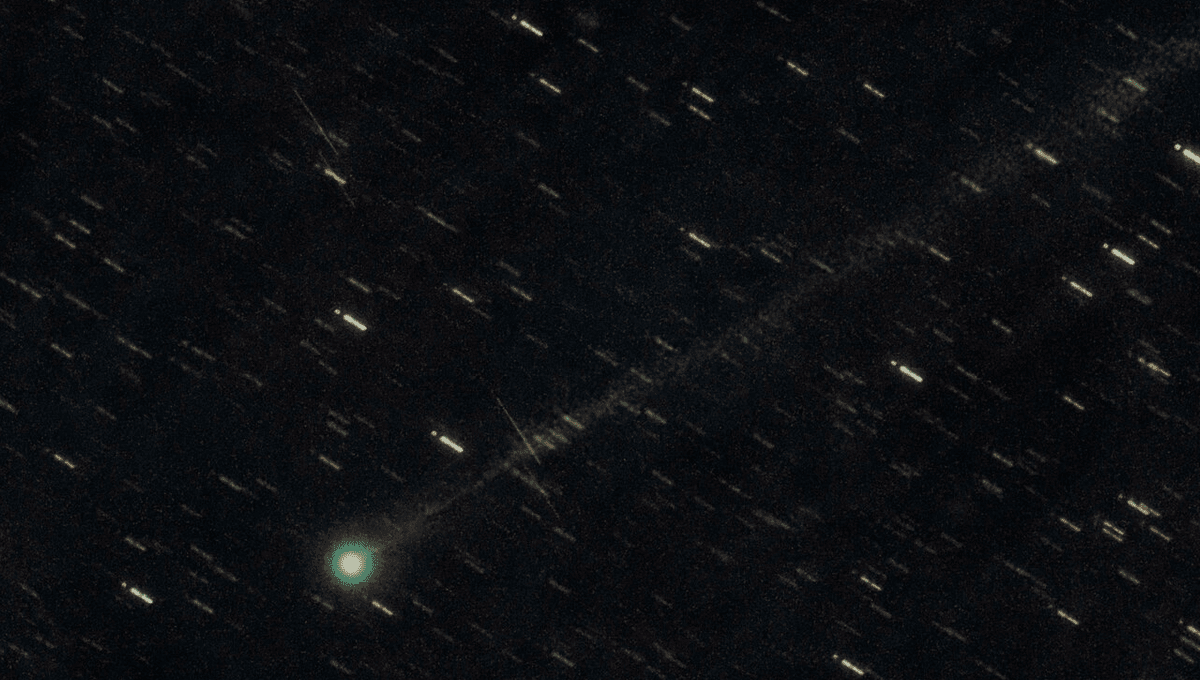
A comet first discovered in late March has already become bright enough to be seen with binoculars under dark skies with a 2-degree tail. It should reach its brightest around May Day and offers a good chance of becoming visible to the naked eye.
The last 12 months have been a bit of a boom period for comet watchers. We had 12P/Pons Brooks peaking in April, C/2023 A3 (Tsuchinshan-ATLAS) in October, and 2024 G3 (ATLAS) this January. All three theoretically achieved peak brightnesses below magnitude 5, the standard measure for an object’s visibility to the naked eye under dark skies. 2024 G3 (ATLAS) was briefly brighter than Venus.
Unfortunately, as is usually the case for comets, those peaks coincided with the icy visitors being very close to the Sun (just 5 degrees in some cases), making them difficult to spot without specialist equipment. Some people did manage to see the comets either before or after their peaks against darker skies, but getting the timing right was hard.
Things could be different for Comet 2025 F2 (SWAN), which was first spotted by amateurs on March 29. Rather than detecting it in their own telescopes, however, Vladimir Bezugly and Michael Mattiazzo noticed something comet-like in images taken using the Solar and Heliospheric Observer (SOHO)’s Solar Wind Anisotropies (SWAN) camera.
Estimates at the time placed the comet at a magnitude of 11, within the range of backyard telescopes away from city lights. When Maik Meyer publicized the news on his Comet Mailing List, amateurs rushed to see if they could find it. Success took until April 2, partially because estimates for the location based on the SWAN images were wrong by 2 degrees.
Comets at magnitudes below 10 usually brighten only slowly, but 2025 F2 (SWAN) (not to be confused with 2020 F8 (SWAN)) has defied that. In the space of a week, it has become 30 times brighter. If this keeps up, it could reach magnitude 5 in the last week of April and stay above that level for almost two weeks.
Moreover, unlike the three recent naked eye comets, 2025 F2 (SWAN) won’t be disappearing into the Sun’s glare from our perspective. On May 1, its anticipated brightest day, it will still be 19 degrees from the Sun in the sky, giving plenty of scope for visibility outside twilight. This could make up for the fact it will probably never get as bright as the examples discussed above.
That said, it doesn’t do to be too confident. Comets have a way of confounding expectations and disappointment is common. One major reason is that they can sometimes break up, causing a brief outburst as more of their ice is exposed to the heat of the Sun, before fading rapidly. This is a particularly common scenario for a comet that has never been this close to the Sun before.
Although 2025 F2 (SWAN) does have the very eccentric orbit common to long-period comets that seldom visit the inner Solar System, it will only get slightly closer to the Sun than Mercury is, unlike “sungrazers” like 2024 S1 and 2024 G3, which got three to 30 times closer.
Part of the reason 2025 F2 (SWAN) has brightened so fast was an outburst on April 5, somewhat like those that got Pons-Brooks nicknamed “The Devil’s Comet”, which may or may not be repeated. Its brightness while still more than 100 million kilometers from the Sun indicates it is probably relatively large, although not in the class of the “Megacomet”.
With the Moon approaching full, the next few days probably won’t be the best time to see this celestial visitor, but that means by the time it’s approaching its brightest point, moonlight will no longer be an issue.
2025 F2 (SWAN) is currently visible in the eastern sky not long before dawn, passing close to the bright star Alpheratz on Sunday, but will move to the evening skies after it passes closest approach.
Although theoretically visible from most of the Southern Hemisphere, 2025 F2 (SWAN) is very much a northern object at the moment, and will stay that way until well after it has reached peak brightness.
Diatomic carbon gives comets a greenish tinge, but this can be stronger or weaker depending on composition. Photographs show 2025 F2 (SWAN) almost as brightly colored as Comet Nishimura, which was dubbed the “green comet” for the intensity of its shade.
Source Link: Less Than A Fortnight After This Comet Was Discovered It's Already Visible In Binoculars